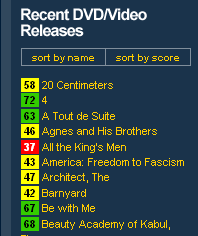Written by Alex Iskold and edited by Richard MacManus
Metacritic, now a property of CNET, has been around
since before the last bubble burst. The site has a unique system for aggregating and
combining the reviews of movies, books, music and video games. This site is very
different from today’s popular review sites, which thrive on communities and social
contribution. Metacritic’s claim to fame is different, because it is an aggregator and
does not require any input from the user. It simply collects relevant content, organizes
it well and then adds a unique scoring system that turns metacritic into an instant
recommendation engine.

Even though metacritic is not new and is not based based on the latest trends, one
look at its Alexa chart is enough to realize that the company is delivering a valuable
service.

This is because we all love to find good information without exerting much (search)
effort. Particularly if the information is quantitative, meaningful and of good quality,
it’s hard to resist. And that’s exactly what metacritic is doing.
Review aggregator
The basic idea behind metacritic is simple – aggregate reviews from different sources
and present them all in one place. For example, here is the list of reviews for Little Miss
Sunshine:

This is just a simple aggregation of reviews from major movie critics across the Web
(from newspapers etc). The value was there already, metacritic just brings it together in
one place. However, metacritic also delivers additional value by turning the reviews into
scores and then coming up with a cumulative score.
Metascores – the scoring system behind metacritic
In addition to the list of reviews, metacritic shows a score for each movie:

Here is how this score is computed. Each critic’s review is given a score on a scale
of 1 to 100. Then, since not all critics are made equal, the system assigns a weight to
each critic. Finally, it computes the total score based on the weighted average of the
individual scores. Here is how metacritic’s scores should be interpreted:

Because the system pulls together all available reviews, the resulting score is a good
indicator of what critics at large think about the movie. If you trust that metacritic
has gotten rid of all bugs over the last 8 years, then the score should be a good guide
for you.
Using Metascores to compare movies
Metacritic takes the scoring yet one
step further and turns movie comparison into an integral part of their user interface.
The sidebars of this site feature the most popular movies and recent movies, with their
scores. A simple red, green and yellow coloring system is an instant winner, as it drives
the ratings value across very well.

Overall, the site is very successful in aggregating a lot of information and
presenting it in a clean way. Visualization techniques like heat maps are typically a
challenge for the general public, but what metacritic does is so simple, that it is
highly likely to be taken well. My only complaint about the site is the black background.
No offense to the sites and blogs that use it, but there should be an option to switch to
a more standard white background for websites.
Conclusion
Looking at metacritic made me wonder what are some other sites that spin the
information in a similar way? After all, metacritic is really just a mashup. A mashup
that aggregates available information and delivers additional value by uncovering hidden
information. And this is the general principle that mashups should follow. Last week’s winner
of mashup camp 3, The Hype Machine, does
a similar thing for popular music. In a way, TechMeme and Original Signal do the same thing for
news. Which then brings us to Technorati most popular. So metacritic has been doing all
along what we just
recently got excited about – popularity based ranking. Except instead of the web,
metacritic uses domain experts.
For a look at similar services, check out Techcrunch’s
An aggregate review of aggregate review services. Please tell us about your favorite
aggregators.

















